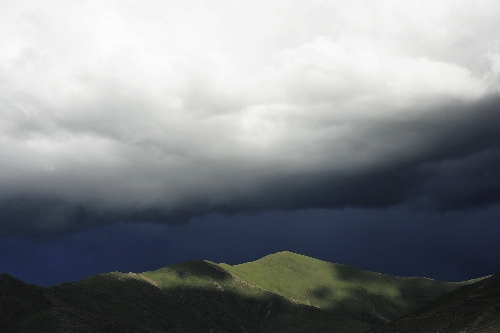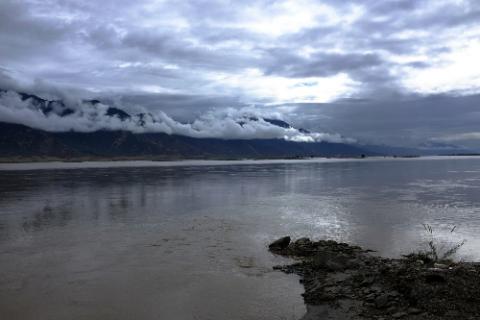
Me desperté temprano en la mañana, empaqué mi equipaje, cargué el auto y desayuné una hora antes de que la ciudad despertara, mi hija y yo ya estábamos conduciendo por la única carretera del Tíbet, en dirección a Shannan para explorar el origen. del primer palacio, el primer monasterio y la primera tierra de cultivo del Tíbet. Después de salir de Lhasa, llovía ligeramente. Cuando salimos de la autopista en el aeropuerto de Gonggar y giramos hacia la carretera hacia la ciudad de Zedang en la prefectura de Shannan, la lluvia finalmente paró. Desde aquí, conduzca hacia el este a lo largo del río Brahmaputra.
El río Yarlung Zangbo se origina en la Región Autónoma del Tíbet de China. En tibetano, "Yarlu" y "Yarlung" significan lo mismo, refiriéndose a venir del cielo, y Yarlung en sí también es un nombre de lugar, que es la actual región de Shannan. Tíbet; " "Zangbu" significa río. Este río finalmente recibió el nombre de "Río Yarlung Zangbo", lo cual es inseparable del hecho de que la tribu Xibuye en el área de Yarlung (los antepasados de Songtsen Gampo) finalmente unificó la meseta Qinghai-Tíbet. Este río atraviesa el principal lugar de nacimiento de la civilización tibetana y los tibetanos lo consideran la "cuna" y el "río madre". Tiene una longitud total de 2.840 kilómetros (incluidos afluentes con una longitud total de 3.848 kilómetros) y un área de drenaje de aproximadamente 935.000 kilómetros cuadrados, de los cuales 2.057 kilómetros están en China y el área de drenaje es de 246.000 kilómetros cuadrados. Es el sexto río más grande de China en términos de longitud (después del río Yangtze, el río Amarillo, Heilongjiang, el río Songhua y el río Perla), el río más grande del Tíbet y el segundo río más grande de India y Bangladesh en términos de volumen de agua. (después del río Yangtze, el río Amarillo, Heilongjiang, el río Songhua y el río Pearl Ganges). Sus tramos superiores son el río de mayor altitud del mundo y el río de mayor pendiente de China.
La fuente del río Brahmaputra es el glaciar Jerma Yangzong (rje ma g.yang vdzoms) en el pie norte del Himalaya en el Tíbet, China. El tramo superior se llama río Maquan (rta mchog kha vbab). de oeste a este, después de atravesar Milin, termina al norte de Medog. Atraviesa el Himalaya, pasa por alto el pico Namjagbarwa en el extremo más oriental del Himalaya y gira hacia el sur, formando el cañón más grande del mundo: el Gran Cañón de Brahmaputra; sale de la Línea de Control Real de China (es decir, McMahon) en la Línea de Inundación Pasika), después de que India invadió la región del Tíbet del sur de China, entró en Assam, India, y pasó a llamarse Río Brahmaputra después de ingresar a Bangladesh, pasó a llamarse Río Jamuna, y pasó a denominarse Río Brahmaputra; convergió con el Ganges en Bangladesh Finalmente desemboca en la Bahía de Bengala, formando el delta más grande del mundo.
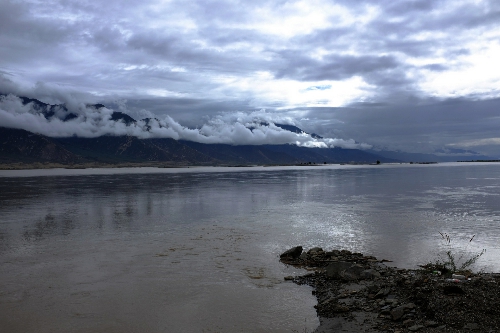
El plan original era ir a la ciudad de Samye al otro lado del río Yarlung Zangbo en el cruce del condado de Zhanang, visitar el monasterio de Samye, el primer templo en el Tíbet, y luego pasar por Zedang para ver Yumbula Kang. Zedang por la noche y mañana por la mañana pasaremos por Yamdrok Yumco. Dirígete a Gyantse. Sólo cuando llegamos al condado de Zhanang supimos que este ferry había estado suspendido durante mucho tiempo. Tuvimos que ir a la ciudad de Zedang para cruzar el puente del río Brahmaputra y luego ir a la ciudad de Samye por la carretera recién construida. 120 kilómetros más de lo previsto inicialmente. Ya era mediodía cuando llegamos a la ciudad de Zedang. Después de encontrar un lugar donde pasar el día, tuvimos que ir primero a Yongbulakang.
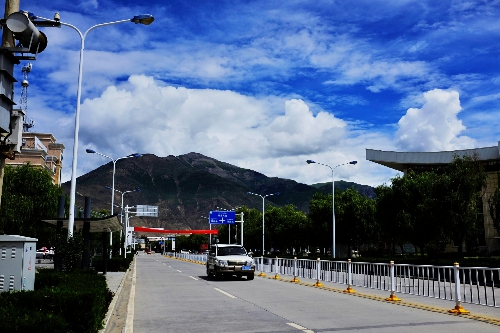
Yongbulakang está a sólo unos 10 kilómetros de Zedang. En el camino, pasará por el templo Changzhu, un monasterio Gelugpa del budismo tibetano. El templo Changzhu fue construido durante el período Songtsen Gampo. Se dice que la princesa Wencheng una vez se detuvo a practicar en este templo. Hay una campana de bronce colgada en el templo. El tesoro del templo es un thangka hecho enteramente de perlas, que es un tesoro raro en el mundo. Esta "Imagen en reposo del Bodhisattva Avalokitesvara" (estatua de pino de Jianqi Mu'e'e), dibujada con perlas ensartadas en líneas, fue creada durante la dinastía Pamo Drukpa en el Tíbet, a finales de la dinastía Yuan y principios de la Ming. Dinastía. Fue creada por la entonces reina del rey Naedong. Realizada con inversión. Todo el thangka mide 2 metros de largo y 1,2 metros de ancho, con un total de 29.026 perlas, un diamante, dos rubíes, un zafiro, 0,55 taeles de zafiro púrpura, 0,91 taeles de turquesa (185 en total) y 15,5 taeles de oro. gramos, 4,1 taeles de coral (1997 piezas en total). Pero nunca he entendido por qué el Buda principal del monasterio Gelug es Padmasambhava, el fundador de la secta Nyingma.
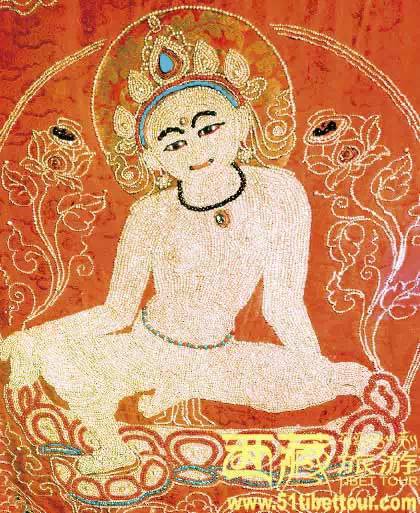
El budismo tibetano fue introducido desde Han y la India cuando Songtsen Gampo estableció la dinastía Tubo. Songtsen Gampo se convirtió al budismo bajo la influencia de la princesa Wencheng y la princesa Chizun. Más tarde, Zanpo Trisong Detsen desempeñó un gran papel en la promoción del desarrollo del budismo tibetano. Dio la bienvenida al monje indio Padmasambhava al Tíbet y fundó la secta Nyingma del budismo tibetano. También construyó el primer templo budista tibetano, el Monasterio Samye. Este período, que duró hasta que Langdama destruyó a Buda, se llama período Qianhong.
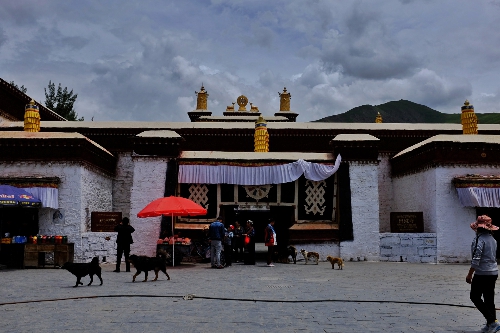
Cúpula Dorada del Templo Changzhu

Tan pronto como entré al templo, vi a un monje tocando las cabezas de los pastores y repartiendo elixires.

Mi hija probó algunas pastillas y dijo que sabían agrias. Los pastores que estaban cerca dijeron que eran cosas buenas.
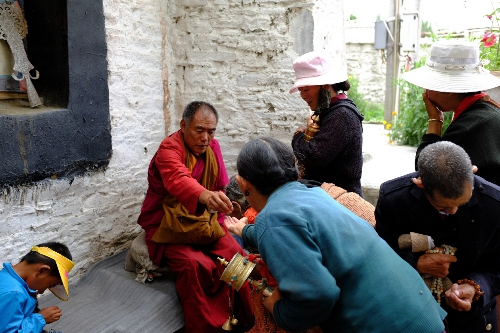
Siga las reglas del budismo tibetano en el templo y visite en el sentido de las agujas del reloj. Lo que más le gusta hacer a mi hija es ofrecer las monedas de diez centavos que se intercambian en la puerta al Buda, que para ella tiene el mismo aspecto y sigue diciendo que cantaba ". Om (ōng) ma (mā) nī (bēi) mēi (hōng), bendíceme con altas puntuaciones en el examen."
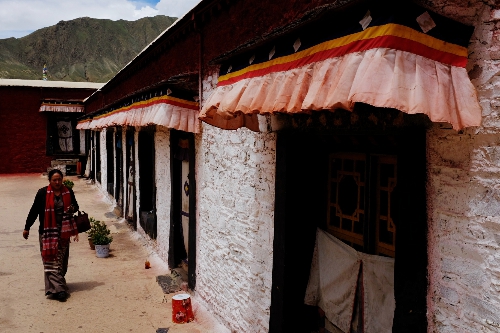
Como de costumbre, no está permitido tomar fotografías en la sala budista del templo. La razón principal es que no se pueden tomar fotografías de las estatuas de Buda, lo cual es una falta de respeto hacia el Buda.

Los pastores que vienen a adorar ofrecen ghee como ofrenda. Cada uno de ellos traerá una bolsa de agua caliente y verterá la mantequilla traída de casa en cada lámpara de mantequilla del templo budista, para que no se apaguen todas las luces. todo el año.
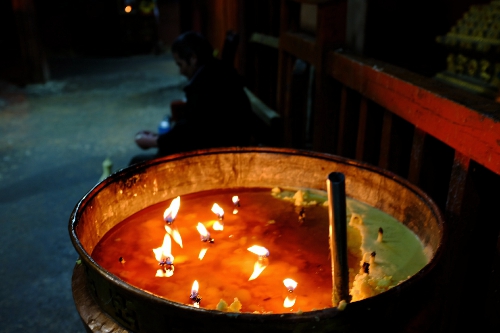
Los pastores que realizan las oraciones traerán algunos recipientes para llevarse a casa el "agua sagrada" del templo.
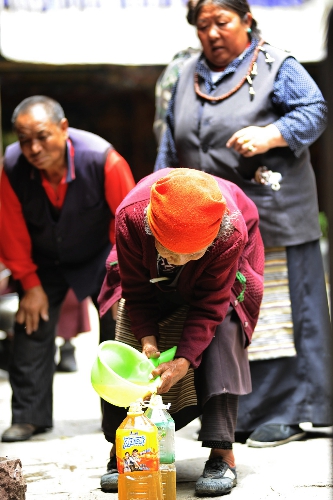
Me lavé el pelo con "agua sagrada" en el templo.
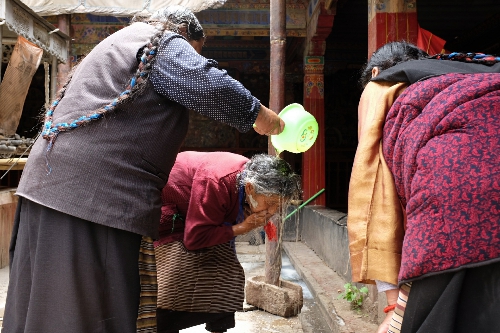
Después de que un pastor le lavara el cabello con "agua sagrada", su sincera felicidad brilló en su rostro marcado por el tiempo. Fue una emoción muy contagiosa. Mi dedo en el obturador de la cámara no pudo detenerlo y tomar esta rara serie de fotografías. .
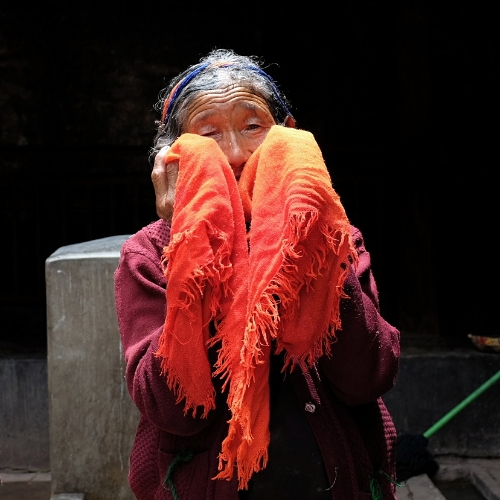
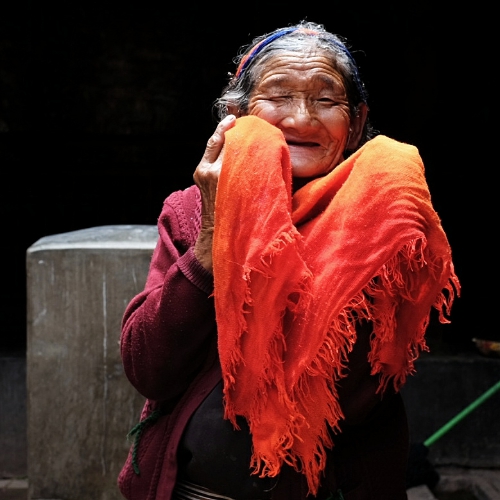
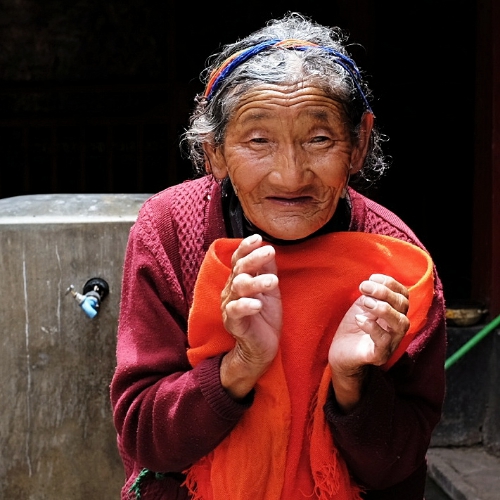

En la última imagen, donde cerré los ojos y disfruté de la protección de Buda, sentí que el color era superfluo. Esta fue la imagen más satisfactoria de este viaje al Tíbet.

El pastor que descansaba a mi lado estaba lleno de confusión acerca de mí. Cuando le reproduje las fotos en la pantalla de la cámara, tenía una sonrisa infantil en su rostro. Quizás nunca entenderé realmente su felicidad.
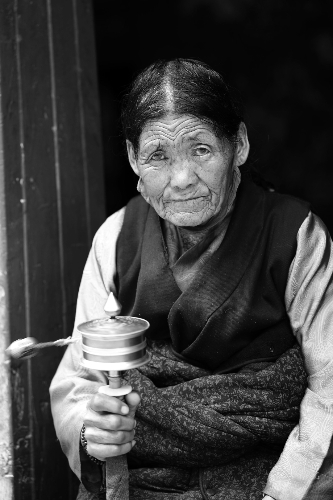
Quizás estos perros tibetanos que duermen tan cómodamente bajo el sol puedan comprender mejor una felicidad tan simple.

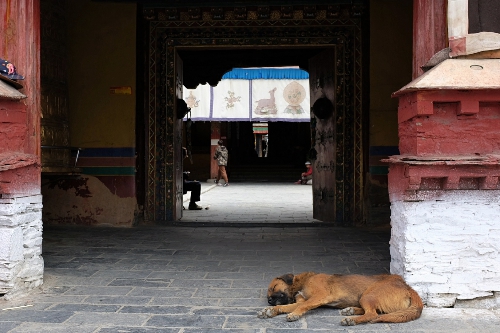
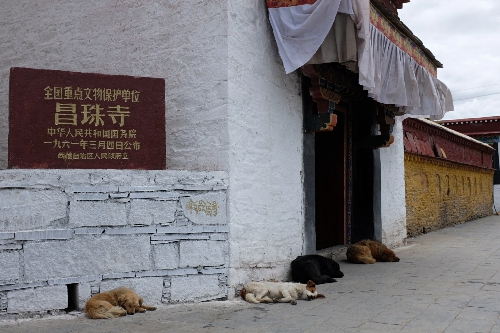
Al salir del templo de Changzhu, la cebada de las tierras altas en los campos se ha vuelto amarilla. Shannan es el granero del Tíbet.
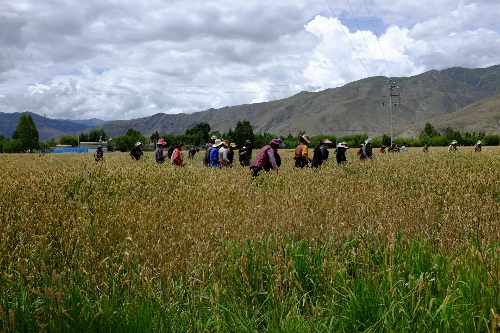
Yumbulakang es el primer palacio en el Tíbet. Según la leyenda, fue construido en el siglo II a. C. Nie Tri Zampu, quien se convirtió en el primer rey tibetano del Tíbet, no solo se convirtió en el "Rey de Inglaterra con un cuello como un". "Trono", también hizo construir el "Palacio Hongliu Xiangsha" de tres pisos especialmente para él. Esta historia en realidad suena bastante familiar. Para decirlo en términos sencillos es como escuchar que alguien de repente ganó un gran premio e inmediatamente pasó a ser un "de clase alta". Persona con una casa y un coche. Esta historia legendaria también está pintada en el mural en la pared del segundo piso del palacio, que es admirado por las generaciones futuras. Como resultado, este palacio también se convirtió en el palacio real de Tubo Zampu en las dinastías pasadas hasta que Songtsen Gampo, la 33.ª generación de Zampu, unificó la meseta y trasladó la capital real a Lhasa. Sin embargo, incluso guerreros sabios como Songtsen Gampo no se atrevían a olvidar Yarlung, la tierra fundamental del Tíbet, y volvían a vivir de vez en cuando. Se dice que la princesa Wencheng pasó su primer verano en Yongbulakang después de casarse con el Tíbet. gastado. Hay otra cosa milagrosa sobre Yongbulakang. Desde la primera generación de Nie Tri Zampu, todas las generaciones de Zampu han adoptado la religión Bon como religión nacional, hasta la generación 28 del período Zangpu Tuotuori Nianzan. Cuenta la leyenda que un día un "objeto divino" cayó del cielo en la cima de Yumbulakang. En su interior había escrituras, instrumentos mágicos y hechizos. Sin embargo, nadie en ese momento conocía la maravilla de estas cosas. Eran cosas buenas, por eso las consagraron. Cuando se levantó, también lo llamó "Ningbo Sangwa", que significa habitación secreta. No fue hasta muchos años después que las generaciones posteriores reconocieron escrituras preciosas como el "Sutra sobre los nombres de los budas y bodhisattvas" en la habitación secreta, y se dieron cuenta de que el budismo había entrado en el Tíbet mucho antes de la época de Songtsen Gampo. Era tan poderoso que no tuvieron más remedio que "lanzar desde el aire" primero y luego "poner una emboscada" para esperar el futuro. Posteriormente, el palacio se convirtió en un lugar sagrado budista y, por tanto, en un templo budista, un lugar de práctica para muchos monjes eminentes y un lugar donde se descubrieron y enterraron muchas "termas".

Montar a caballo hasta Yongbulakang y contemplar los campos de cereales al pie de la montaña.

Quizás Songtsen Gampo estaba allí contemplando la cosecha de cebada de las tierras altas, esperando la pronta finalización del Palacio Potala en Lhasa y casarse con la princesa Wencheng de la dinastía Tang.
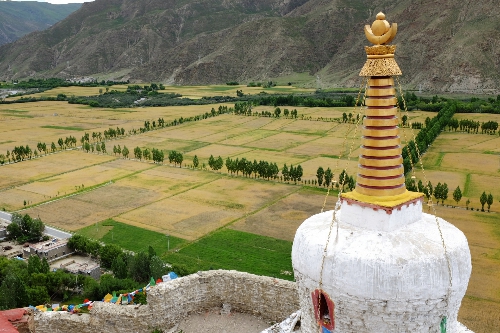
Mientras jugaba con las piedras Mani en la pared del palacio, su hija dijo que la construcción del Palacio Potala por Songtsen Gampo para la princesa Wencheng era sólo una excusa, y que su verdadero propósito era gobernar el Tíbet.
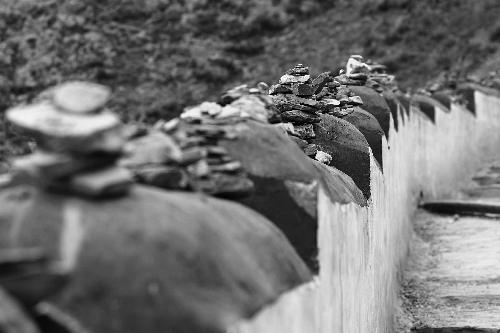
Al lado del camino al pie de Yumbulakang, hay una losa de piedra erigida en un pequeño campo. Esta es la primera tierra de cultivo en el Tíbet.

El interés de mi hija por las cabras va mucho más allá de las tierras de cultivo.
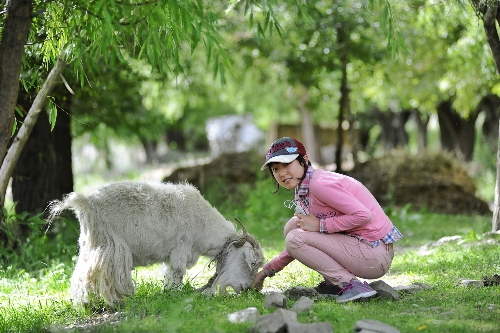
Todavía era temprano cuando bajamos de Yumbulakang. Continuamos por el camino y pasamos por un pueblo. Vi gente vestida con trajes festivos reuniéndose en la pequeña plaza del comité del pueblo. Resultó que hoy era el "Festival de la Fruta". "de este pueblo.
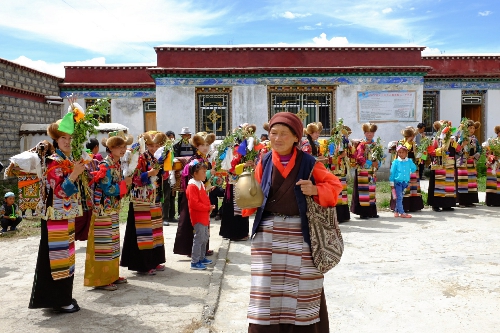
"Wangguo" es la transliteración tibetana, que significa "dar vueltas alrededor de la tierra". La palabra tibetana "Wang" se refiere a los días de agricultura y "Guo" significa dar vueltas en círculos. El festival "Wangguo" puede traducirse como "el día de dar vueltas en círculos en el borde de los campos". Porque en la mañana del primer día del festival, cuando el sol llena los dorados campos de trigo, los agricultores sostendrán espigas y desfilarán por las tierras de cultivo. Al frente hay una guardia de honor compuesta por lamas y viejos agricultores, sosteniendo altas estatuas de Buda. , llevando escrituras y tocando trompetas de Buda, gracias a Dios por brindarle a la gente un buen año con buen clima y buen clima. Para los agricultores trabajadores, ver las cosechas que están a punto de ser cosechadas y respirar la fragancia de los campos de trigo resulta alegre y embriagador, y cantan antiguas canciones de cosecha.
El Festival Wangguo tiene una historia de más de 1.500 años. Es un festival tradicional para que los agricultores tibetanos celebren la cosecha. Es popular en Lhasa, Shigatse, Shannan y otros lugares de la Región Autónoma del Tíbet. Se lleva a cabo en el séptimo y octavo mes del calendario tibetano cada año. La fecha específica cambia con los cambios en las estaciones agrícolas en varios lugares. Generalmente se lleva a cabo después de que la cebada de las tierras altas esté madura y dos o tres días antes de que esté madura la hoz. Se cosecha y dura de uno a tres días. Por lo tanto, el calendario del Festival Wangguo se basa en el municipio y lo deciden colectivamente los aldeanos en función de la madurez de los cultivos locales.

Lama presidiendo la ceremonia del Festival Wangguo
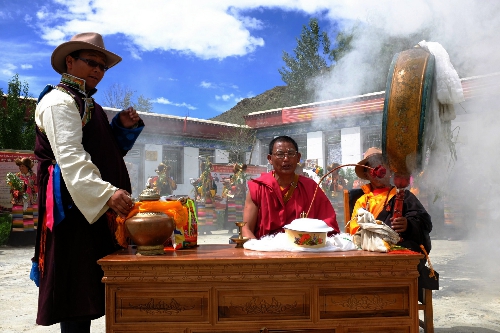
La alegría de la cosecha está escrita en los rostros de los aldeanos.
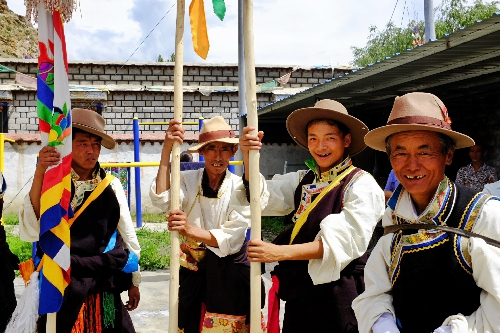
El tímido aldeano se cubrió la cara con el objeto que tenía en la mano.
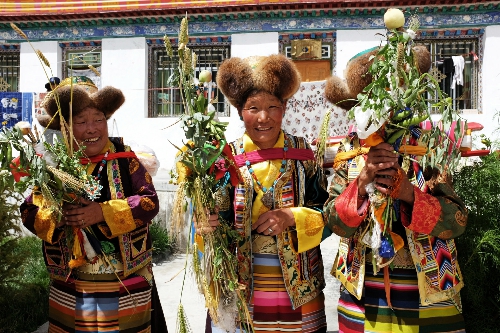
El baterista me miró sentado en la pared tomando fotografías.
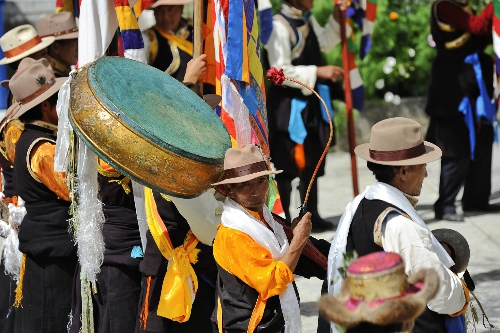
Un grupo de turistas tomó fotografías de las dos bellezas con sus teléfonos móviles.
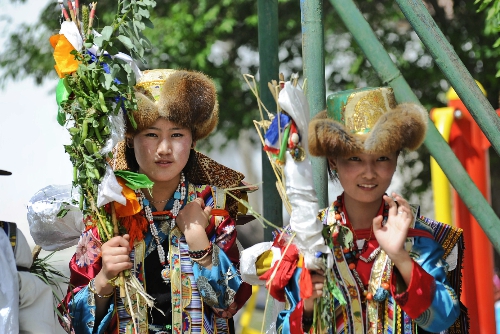
Después de ver la ceremonia del Festival Wangguo, regresamos a Zedang. El sol se pone por el oeste y las tierras de cultivo bajo la cálida luz tienen un color como el de una pintura al óleo.

Sólo el Tíbet tiene un cielo tan magnífico.
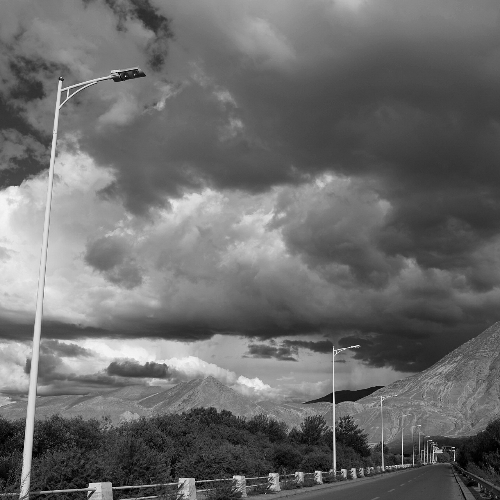
Hay varios recolectores de trigo profesionales del continente al borde de la carretera, lo que me recuerda a los recolectores de trigo profesionales de "A Bite of China 2".
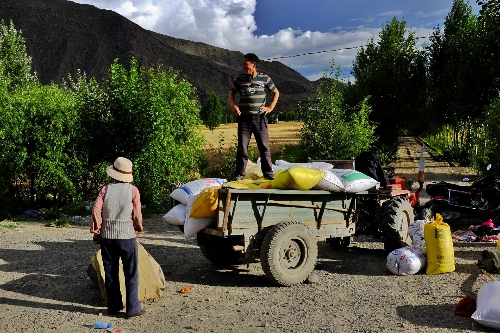
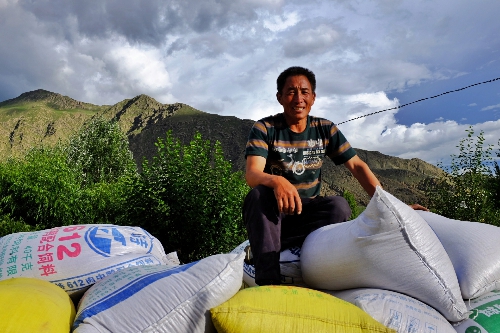
Sólo queda un rayo de sol en la cima de la montaña envuelta en nubes oscuras y se acerca la lluvia. . . . . .
